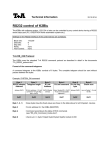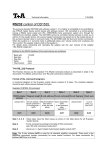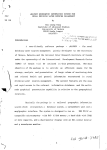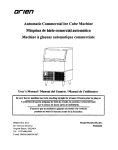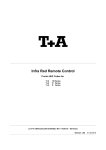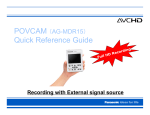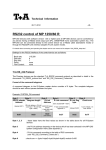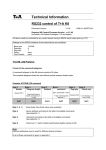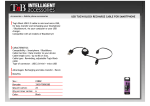Download RS232 Command-set f. K1AV
Transcript
T Technical Information 20.11.2012 V1.21 RS232 control of K1AV. The DVD receiver K1AV is compatible to be controlled by a connected control-system having a RS232 serial output port (PC, CRESTRON home automation system etc.) through the RS232/R-Link interface adapter. For details about connecting and operating the adapter see the user manual of the adapter “UM_RS232_Adapt.doc”. Settings for the RS232 interface of the control device are as follows: Baud rate: Data bits: Stop bits: Parity: Flow Control: 115.200 8 1 none none T+A RS_232 Protocol The R-series devices use the standard T+A RS232 command protocol as described in detail in the documents “TA_RS232_protocol.doc” and “RS_232_Command_Codes.doc”. Format of the command telegrams A command telegram to the R-system master device consists of 6 bytes. The complete telegram should be sent without pauses between the bytes. Example: SYSTEM_ON command Byte 1 Byte 2 Byte 3 RS232 adapter Telegram length R-Link Address Address (R-Link address + R-Link (0xC8=Amplifier/ command + R-Link flag master device byte = 0x03) see also note below) (always 0x01) 0x01 0x03 Byte 4 Byte 5 Byte 6 R-Link command R-Link flag Check sum byte (here: SystemON = 0x57) see command table “appendix 1” (always 0x02) = sum of bytes 1..5 mod. 0x100 0x57 0x02 0x25 0xC8 Byte 1, 2, 3, 5 : these bytes have the fixed values as shown in the table above for all R-system master devices Byte 4 : R-Link command according to the table of RCII commands (see “RS_232_Command_Codes.doc”) Byte 6 : check sum == (byte1+byte2+byte3+byte4+byte5) modulo 0x100 Note: The R-Link address 0xC8 is used for all standard amplifier commands. There exist a few additional commands (system commands) for some special functions. For these commands the address 0xC4 has to be used. At this time there are non of these relevant for surround control. Format of the acknowledge (ACK) telegrams The R-System master device will process each received command telegram and it will send an acknowledge telegram approx. 25...35 ms after receiving the command. The ACK telegram consists of 2 bytes: Byte 1 is the RS232 address of the command telegram received before (=byte 1 of the command telegram = 0x01). Byte 2 is the acknowledge byte. If this byte is equal to the check sum of the command telegram (byte_6 of the command) then the command was received correctly. If byte_2 has a value different from the check sum of the command, an error has occurred (see table below). Format of the ACK telegram: Byte 1 Byte 2 RS232 address 0x01 ACK byte = check sum of command: = check sum –1: = check sum –2: command correctly received command ignored (system busy) command not executed Note: If no ACK telegram is received within 35 milli-seconds after sending a command, there is either a hardware problem (cable etc.) or the telegram is erroneous (wrong address, wrong check sum ....) After the ACK telegram, the master device is ready for the next command. Special System Commands The K1AV automatically pushes the status information after it has changed. Additionally the status can be requested by sending the command 0x64 (Status_1) or 0x43 (Status_2) to the RLink-address 0xC4 but normally this should not be necessary . We strongly recommend to keep the number of status requests low to avoid unnecessary RLink-Bus load. The information given is different for each device and has to be decoded and displayed individually. For further information see the user manual ‘Crestron T+A Macro’. Responses of the K1AV are as follows: Status 1: The STATUS_1 is automatically pushed by the K1AV when any contained information has changed or the command STATUS_1 was sent to the K1AV. It is answered by a 9 byte long status telegram having the following format: 0x01, 0x06, 0xC4, 0x64, Stat_Byte_1, Stat_Byte_2, Stat_Byte_3, Stat_Byte_4, Checksum -----------------------------------|---------------------------------------------------------------------------|----------------HEADER (4) STATUS BYTES (4) CHK-SUM (1) The 4 header bytes (0x01/0x06/0xC4/0x64) are constant. The 4 status bytes are defined as follows: Stat_Byte_1 Stat_Byte_2 Stat_Byte_3 Stat_Byte_4 b0 b1 b2 b3 b4 b5 b6 b7 Speaker_A Speaker_B 1:= speaker A output is ON 1:= speaker B output is ON STANDBY ON 1:= System is in STANDBY 1:= System is ON b0 b1 b2 b3 b4 b5 b6 b7 Listen Source (0...15) 0:= not defined 1:= unused 2:= TUNER 3:= TAPE 4:= unused 5:= TV/Video 6:= AUX 7:= unused b0 b1 b2 b3 b4 b5 b6 b7 LOUDness FLAT b0 b1 b2 b3 b4 b5 b6 b7 Recording Source (0...15) 1:= Loudness is ON 1:= FLAT is ON 1:= Stereo 0:= analog 0:= None 8:= unused 9:= DISC 10:= unused 11:= unused 12:= unused 13:= unused 14:= unused 15:= not def. / future use (= Tone defeat) Status 2: The STATUS_2 is automatically pushed by the K1AV when the volume has changed or the command STATUS_2 was sent to the K1AV. It is answered by a 7 byte long status telegram having the following format: 0x01, 0x04, 0xC4, 0x43, Status_Byte_1, Status_Byte_2, Checksum -----------------------------------|---------------------------------------------------------------------------|----------------HEADER (4) STATUS BYTES (2) CHK-SUM (1) The 4 header bytes (0x01/0x04/0xC4/0x43) are constant. The 2 status bytes are defined as follows: Status_Byte_1 b0 b1 b2 b3 b4 b5 b6 b7 Volume of main room (0...63) Stat_Byte_2 b0 b1 b2 b3 b4 b5 b6 b7 Volume of 2nd room (0...63) Appendix 1: List of Master (Amplifier) commands (Address 0xC8) Command Code (HEX) Power Control System ON 1) 0x57 System Standby 1) 0x77 System OFF 1) 0x7A On/Standby 1) 0x01 Volume + Tone Control VOL_PLUS 0x00 VOL_MINUS 0x20 VOL_B_PLUS 2) 0x4E VOL_B_MINUS 2) 0x6E Balance_L Balance_R LOUDness LOUDness ON LOUDness OFF FLAT FLAT ON FLAT OFF Speaker Control SPKR 0x38 0x18 0x2C 0x75 0x55 0x0C 0x7B 0x47 0x13 toggle Remark x Switch the K1AV ON Switch the K1AV to STANDBY Switch the system to STANDBY Toggle the K1AV between ON and STANDBY Performs 1 volume step of the main room volume. Hint: Repeat these commands for continuous volume increase/decrease (command repetition rate = 100...110 ms) Performs 1 volume step of the 2nd room volume (if enabled) Hint: Repeat these commands for continuous volume increase/decrease (command repetition rate = 100...110 ms) one step to the left (only main room) one step to the right (only main room) x x tone control defeat tone control on x Switches the speaker outputs in sequence: A -> B -> A+B Hint: better use the Speaker_A/B_ON/OFF commands Speaker A output ON Speaker A output OFF Speaker B output ON Speaker B output OFF Speaker A on/off Speaker B on/off Speaker A and B off Speaker_A ON 0x68 Speaker_A OFF 0x48 Speaker_B ON 0x58 Speaker_B OFF 0x78 Speaker_A 0x1C x Speaker_B 0x3C x Off 0x2E Source selection (Group commands) CD 0x23 x DISC Tuner 0x17 Tuner Tape 0x35 Tape Video/TV 0x07 x TV AUX 0x3D x AUX Source selection (discrete commands) SRC_CD 0x45 DISC SRC_Tuner 0x46 Tuner SRC_Tape-1 0x49 Tape SRC_TV 0x59 TV SRC_Aux 0x65 AUX SRC_DVD 0x42 DISC SRC_STB 0x62 STB Main / Config - Menu AMP Menu (short) 0x40 Open Main Menu AMP Menu (long) 0x41 Open Configuration Menu Close AMP Menu 0x60 Close active Menu (Main or Configuration) Hint: The Menu navigation is done by the keys NEXT (0x34), PREV (0x2A), FF (0x25), RW (0x1A) and OK (0x26) or with Cursor_UP/DOWN/LEFT/RIGHT and SELECT (0xD2,0xD3,0xD4,0xD5,0xD6) (which are normally forwarded to the active source device. Sound control SURND 0x37 x toggle between Stereo / 3ch Music / 3ch Movie - Mode Stereo Mode 3) 0x4D select Stereo Mode 3ch Music Mode 3) 0x69 select 3ch Music Mode (only if center channel enabled) 3ch Movie Mode 3) 0x7E select 3ch Movie Mode (only if center channel enabled) Command Tuner control Tune UP ( >> ) Tune DOWN ( << ) STOP PREV ( |<) NEXT ( >|) OK Rewin Fast Forward Previous Next Cursor UP 2) Cursor DOWN 2) Cursor LEFT 2) Cursor RIGHT 2) Select / Activate 2) 0 1 2 3 4 5 6 7 8 9 F3/4 F3 2) Open SRC Menu 1 Close SRC Menu 2) Code (HEX) 0x25 0x1A 0x24 0x2A 0x34 0x26 0xCA 0xCB 0xCC 0xCD 0xD2 0xD3 0xD4 0xD5 0xD6 0x03 0x3A 0x06 0x16 0x02 0x09 0x3B 0x31 0x11 0x39 0x0B 0x85 0xC5 0xC7 toggle Remark x x Frequency one step up (25 kHz) / cursor right Frequency one step down (25 kHz) / cursor left Stop frequency scan / exit menu previous preset / cursor down next preset / cursor up temporary Preset display / cursor action fast rewind fast forward previous track/title/chapter next track/title/chapter cursor up cursor down cursor left cursor right select / activate / enter key "0" key "1" key "2" key "3" key "4" key "5" key "6" key "7" key "8" key "9" toggle Radiotext on/off toggle Radiotext on/off open Tuner setup menu close Tuner setup menu Command DISC control Tune UP ( >> ) Tune DOWN ( << ) STOP PREV ( |<) NEXT ( >|) OK Rewind Fast Forward Previous Next Play Cursor UP 2) Cursor DOWN 2) Cursor LEFT 2) Cursor RIGHT 2) Select / Activate 2) PAUSE OPEN/CLOSE 0 1 2 3 4 5 6 7 8 9 F1 2) F2 2) F3 2) F5 2) F1/2 F3/4 F5/6 Open SRC Menu 1 Open SRC Menu 2 Close SRC Menu 2) Code (HEX) 0x25 0x1A 0x24 0x2A 0x34 0x26 0xCA 0xCB 0xCC 0xCD 0x12 0xD2 0xD3 0xD4 0xD5 0xD6 0x05 0xCE 0x03 0x3A 0x06 0x16 0x02 0x09 0x3B 0x31 0x11 0x39 0x83 0x84 0x85 0x8E 0x36 0x0B 0x36 0xC5 0xC6 0xC7 toggle Remark x x x x x x x x context dependant fast forward / cursor right context dependant fast rewind / cursor left STOP context dependant previous track/title/chapter / cursor down context dependant next track/title/chapter / cursor up PLAY / select/confirm fast rewind fast forward previous track/title/chapter next track/title/chapter Play cursor up cursor down cursor left cursor right select / activate / enter PAUSE OPEN / CLOSE key "0" key "1" key "2" key "3" key "4" key "5" key "6" key "7" key "8" key "9" toggle Soundtrack toggle Angle toggle Subtitle REPEAT Audio track (F6-key F1/2) Subtitle (F6-key F3/4) Repeat (F6-key F5/6) Open Title menu Open Player setup-menu Close Player setup-menu 1) Commands not available in software version prior to V1.11 (K1AV with older versions must be manually switched on before being operated through RS232. 2) added with V1.12 3) added with V1.20 Revision history: 16.03.2006 27.03.2006 06.04.2006 29.05.2006 30.08.2006 20.11.2012 V1.00 V1.10 V1.11: - K1AV does not need to be switched ON manually before using RS232 commands anymore. - changed Status_1 and Status_2 to match SR1535 status words. V1.12: - added commands: - F1,F2,F3,F5 - discrete Cursor up,down,left,right - discrete Select / Activate - discrete Next,Previous,Rewind,Fast forward - Close_Src_Menu V1.20: - added discrete commands for: - Stereo Mode - 3CH-Music Mode - 3CH-Movie Mode V1.21 Checksum computation corrected (mod 0x100)









